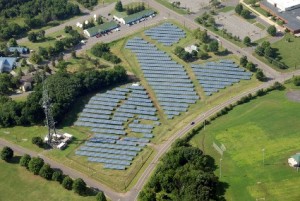This seems to be worse than Chernobyl. Chernobyl was a meltdown at one reactor. There are reports of “partial melt-downs” at three reactors at Fukushima Dai-Ichi and “States of Emergency” at 9 out of 17 reactors at three sites northeast of Tokyo: 3 at Fukushima Dai-ichi, 3 at Fukushima Daini and 3 at Onagawa. I expect the others at Dai-ichi to be shut down.
“The chairman of the United States Nuclear Regulatory Commission gave a far bleaker appraisal on Wednesday of the threat posed by Japan’s nuclear crisis than the Japanese government had offered. He said American officials believed that the damage to at least one crippled reactor was much more serious than Tokyo had acknowledged, and he advised Americans to stay much farther away from the plant than the perimeter established by Japanese authorities.
“The announcement opened a new and ominous chapter in the five-day-long effort by Japanese engineers to bring the six side-by-side reactors under control after their cooling systems were knocked out by an earthquake and a tsunami last Friday.”
– David Sanger, Matthew Wald, and Hiroko Tabuchi, NY Times, “U.S. Calls Radiation ‘Extremely High,’ Sees Japan Nuclear Crisis Worsening
Also in the NY Times, William Broad reports “Scientists Project Path of Radiation Plume” … “A United Nations forecast of the possible movement of the radioactive plume coming from crippled Japanese reactors shows it churning across the Pacific and touching the Aleutian Islands on Thursday before hitting Southern California late Friday [March 18, 2011].”
It is important to remember that this is not just radiation, but particles carried on the wind that are emitting radiation.
Buy iodine. It may be bad for your blood pressure, but then again so are meltdowns, even those half-a-world away.
The damage to north-east Japan is not incalculable. A small number of people were killed. A large number of cancers will develop. A significant percentage of Japan’s electric capacity – 9 out of 17 nuclear power plants – is down. An area of 2,826 to 7,850 square miles – a radius of 30 to 50 miles – around Fukushima Daiichi must be closed. Radioactive material is flushed from the damaged reactors into the Pacific. The heavy metals will sink to the ocean floor and eventually get buried in sediments. This will be bad for fish, dolphins, etc., however, there will be no humans there to fish …
Three questions: Indian Point, Oyster Creek, and Vermont Yankee are of the same design as Fukushima Daiichi. Why did the NRC just relicense Vermont Yankee? Why does the NRC not pull the licenses from Oyster Creek and Indian Point? Should we not decommission all nuclear reactors with all deliberate speed and replace them with a clean, renewable, sustainable energy topology?
Summary:
- Fukushima Dai-ichi 1, 2, 3: Partial meltdowns.
- Diani 1, 2, & 4: Equipment failure, including cooling system failure.
- Onagawa 1, 2 and 3: High levels of radiation.
Details: (AP courtesy of the Boston Globe)
Dai-ichi Unit 1: Some uranium fuel pellets in the core have melted. Workers are trying to prevent total meltdown, have released steam in attempt to lower pressure in reactor vessel. A hydrogen explosion blew away much of the containment building. The reactor core is said to be intact. The cooling system has failed; large amounts of seawater is being pumped into reactor vessel to try cooling the severely overheated uranium core. Offsite radiation has been reported.
Dai-ichi Unit 2: Cooling system failure. Officials say fuel rods have been fully exposed, at least twice. An attempt to channel seawater into the reactor failed due to stuck rod, so officials were trying to spray cool water on the top of the reactor vessel. Explosion occurred early Tuesday [11/15] at this reactor. Partial meltdown believed to have occurred.
Dai-ichi Unit 3: Hydrogen explosion on Monday [11/14]. Radiation believed released. Cooling system failure so jury-rig of seawater pump to cool the unit. Partial meltdown said to have occurred.
Daini units 1, 2 & 4: Cooling system breakdown or failure. Retained offsite power, but operators were experiencing equipment failures and increased pressure inside the containment vessels. There have been problems with residual heat removal systems.
Onagawa units 1, 2 & 3: Higher-than-permitted radiation levels detected. When the levels fell, they said the radiation could have been from a release at the Dai-ichi units.
Third in a series on the economics, ecological economics, finance, logistics, and systems dynamics of nuclear power in the light of the ongoing catastrophe at Fukushima.



















